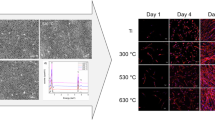Abstract
Nanostructures have pronounced effects on biological processes such as growth of cells and their functionality. Advances in biomaterial surface structure and design have resulted in improved tissue engineering. Nanotechnology can be utilized for optimization of titanium implants with a formation of vertically aligned TiO2 nanotube arrays on the implant surface. The anodic oxidation of the titanium implant surface to form a TiO2 nanotube array involves electrochemical processes and self assembly. In this paper, the mechanism of nanotube formation, nanotube bio-characteristics, and their emerging role in soft and hard tissue engineering as well as in regenerative medicine will be reviewed, and the beneficial effects of surface nanotubes on cell adhesion, proliferation, and functionality will be discussed in relation to potential orthopedics applications.
Similar content being viewed by others
References
S. Oh et al., “Significantly Accelerated Osteoblast Cell Growth on Aligned TiO2 Nanotubes,” J. Biomed. Mater. Res. A, 78 (2006), p. 97.
K.S. Brammer et al., “Enhanced Cellular Mobility Guided by Ti02 Nanotube Surfaces,” Nano. Lett., 8 (2008), p. 786.
K.S. Brammer et al., “Improved Bone-forming Functionality on Diameter-controlled Ti02 Nanotube Surface,” Acta Biomaterialia, 5(8) (2009), pp. 3215–3223.
A.S. Curtis, M. Dalby, and N. Gadegaard, “Cell Signaling Arising from Nanotopography: Implications for Nanomedical Devices,” Nanomed., 1 (2006), p. 67.
M.J. Dalby et al., “Genomic Expression of Mesenchymal Stem Cells to Altered Nanoscale Topographies,” J. Royal Soc. Interface, 5(26) (2008), pp. 1055–1065.
M.J. Dalby et al., “In vitro Reaction of Endothelial Cells to Polymer Demixed Nanotopography,” Biomaterials, 23 (2001), p. 2945.
J.O. Gallagher et al., “Interaction of Animal Cells with Ordered Nanotopography,” IEEE Trans Nanobloscience, 1 (2002), p. 24.
J. Park et al., “Nanosize and Vitality: Ti02 Nanotube Diameter Directs Cell Fate,” Nano. Lett., 7 (2007), p. 1686.
M.J. Dalby, “Nanostructured Surfaces: Cell Engineering and Cell Biology,” Nanomed., 4 (2009), pp. 247–248.
M.J. Dalby et al., “Osteoprogenitor Response to Semi-ordered and Random Nanotopographies,” Biomaterials, 27 (2006), pp. 2980–2987.
M.J. Dalby, D. Pasqui, and S. Affrossman, “Cell Response to Nano-islands Produced by Polymer Demixing: A Brief Review,” IEE Proc. Nanobiotechnol., 151 (2004), pp. 53–61.
M.J. Dalby et al., “Nanotopographical Control of Human Osteoprogenitor Differentiation,” Curr. Stem Cell Res. Then, 2 (2007), pp. 129–138.
M.J. Dalby et al., “Nanomechanotransduction and Interphase Nuclear Organization Influence on Genomic Control,” J. Cell Biochem., 102 (2007), pp. 1234–1244.
H.E. Prakasam et al., “A New Benchmark for Ti02 Nanotube Array Growth by Anodization,” J. Phys. Chem. C, 111 (2007), pp. 7235–7241.
S. Prakash et al., Advanced Inorganic Chemistry,Vol. II (New Delhi, India: S. Chand & Co., Ltd., 2005), p. 2.
J. Tao et al., “Mechanism Study of Self-organized Ti02 Nanotube Arrays by Anodization,” New Journal of Chemistry, 32 (2008), p. 2159.
S. Oh et al., “Ti02 Nanotubes for Enhanced Cell and Bone Growth,” Recent Developments in Advanced Medical and Dental Materials Using Electrochemical Methodologies, ed. R.L. Karlinsey (Kerala, India: Research Signpost, 2009), p. 199.
L. Under et al., “Clinical Aspects of Osseointegration in Joint Replacement—A Histological Study of Titanium Implants,” J. Bone Joint Surg. Br., 70 (1988), p. 550.
R.M. Pillar, J,M. Lee, and C. Maniatopoulos, “Observation on the Effect of Movement on Bone Ingrowth into Porous-surfaced Implants,” Clin. Orthop. Rel. Res., 208 (1986), pp. 108–113.
K. Satomi et al., “Bone-implant Interface Structures after Nontapping and Tapping Insertion of Screw-type Titanium Alloy Endosseous Implants,” J. Prosthet. Dent, 59 (1988), p. 339.
S.H. Oh et al., “Growth of Nano-scale Hydroxyapatite using Chemically Treated Titanium Oxide Nanotubes,” Biomaterials, 26 (2005), p. 4938.
L. Ponsonnet et al., “Relationship between Surface Properties (Roughness, Wettability) of Titanium and Titanium Alloys and Cell Behaviour,” Materials Science and Engineering C, 23 (2003), pp. 551–560.
B.D. Boyan et al., “Role of Material Surfaces in Regulating Bone and Cartilage Cell Response,” Biomaterials, 17 (1996), p. 137.
D.E. Ingber, “Cellular Tensegrity: Defining New Rules of Biological Design that Govern the Cytoskeleton,” J. CellSci., 104 (1993), pp. 613–627.
E. Martinez et al., “Effects of Artificial Micro- and Nano-structured Surfaces on Cell Behavior,” Annals of Anatomy, 191 (2009), pp. 126–135.
L.M. Bjursten et al., “Titanium Dioxide Nanotubes Enhance Bone Bonding in vivo,” J. Biomed. Mater. Res., 92(3) (2010), pp. 1218–1224.
S. Oh et al., “Stem Cell Fate Dictated Solely by Altered Nanotube Dimension,” Proc. Natl Acad. Sci. USA, 106(7) (17 Feb 2009), pp. 2130–2135.
R. McBeath et al., “Cell Shape, Cytoskeletal Tension, and RhoA Regulate Stem Cell Lineage Commitment,” Dev. Cell, 6 (2004), pp. 483–495.
S.A. Ruiz and OS. Chen, “Emergence of Patterned Stem Cell Differentiation within Multicellular Structures,” Stem Cells, 26 (2008), pp. 2921–2927.
A.J. Engler et al., “Extracellular Matrix Elasticity Directs Stem Cell Differentiation,” J. Musculoskelet. Neuronal Interact, 7 (2007), p. 335.
Author information
Authors and Affiliations
Corresponding author
Rights and permissions
About this article
Cite this article
Brammer, K.S., Oh, S., Frandsen, C.J. et al. TiO2 nanotube structures for enhanced cell and biological functionality. JOM 62, 50–55 (2010). https://doi.org/10.1007/s11837-010-0059-x
Published:
Issue Date:
DOI: https://doi.org/10.1007/s11837-010-0059-x




